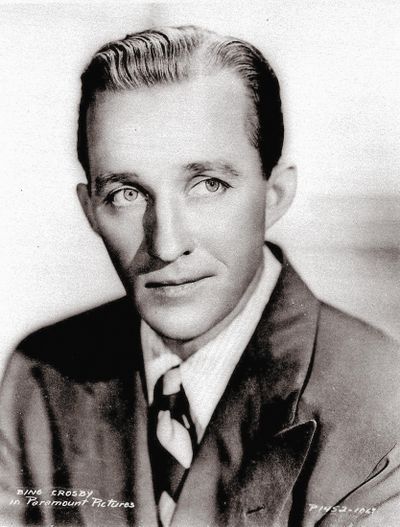Dreaming of a Bing Christmas: Film festival is Saturday

They don’t really make movie stars in the mold of Bing Crosby anymore. It’s hard to imagine him having a place in today’s pop culture landscape: He’s maybe a little too nice and too urbane, and the kinds of movies he made haven’t been in fashion for decades.
But perhaps that’s why audiences keep returning to the Bing Crosby Holiday Film Festival, which is now in its 10th year. It’s a daylong festival at Crosby’s namesake downtown theater, and it features three Crosby films, a display of Crosby-related memorabilia and a performance by the legendary crooner’s nephew Howard Crosby. There’s plenty of nostalgia to experience.
Crosby was one of the first musical superstars of the modern era. Although a majority of his work predates traditional Billboard charts, he racked up more than 40 No. 1 singles during his career and has sold an estimated 1 billion records. He also had a long and successful movie career, years before the likes of Frank Sinatra, Dean Martin and Elvis Presley transitioned into film. He had significant box office presence in the ’40s and ’50s and won an acting Oscar for his starring role in 1944’s “Going My Way.”
Crosby’s star faded a bit in the late ’50s, when popular music was usurped by the rebellious energy of rock ’n’ roll. But much of his work is still cherished, perhaps because it so perfectly captures the warmth and romance of a specific era. As a screen presence, Crosby was all soft edges and, excluding his dramatic turn alongside Grace Kelly in 1954’s “The Country Girl,” always appeared to be the gentle, amiable personification of one of his classic songs.
The festival’s lineup almost always includes two of Crosby’s most famous films – “Holiday Inn” and “White Christmas,” which nearly function as companion pieces – as well as something a little less expected. Here’s what’s playing on the Bing’s big screen this year:
“A Connecticut Yankee in King Arthur’s Court” (1949) – This musical adaptation of Mark Twain’s classic time-travel story is hardly one of Crosby’s most famous films (though it was a modest hit upon release), which makes it a nice change of pace from the holiday perennials. Crosby plays an American blacksmith-turned-auto mechanic who falls off his horse in the 20th century and magically wakes up in Camelot, outsmarting the locals with his knowledge of modern science and technology and immediately catching the eye of the king’s beautiful niece. It’s a movie of small, simple pleasures: It’s bright and colorful and features a couple of memorable Crosby songs, including “Busy Doing Nothing” and “If You Stub Your Toe on the Moon.”
“Holiday Inn” (1942) – This is where the Irving Berlin-penned tune “White Christmas” first appeared; 73 years later, it’s still the best-selling single of all time. The film itself holds up almost as well as its most famous tune, save, of course, for some unfortunate racial stereotyping and a cringe-inducing number in which Crosby and his band don blackface. But the story is classically modest, a romance involving two song-and-dance men (the second is Fred Astaire) vying for the affections of their former performing partner (Virginia Dale) at an idyllic country resort. Irving Berlin’s score includes tunes like “Be Careful, It’s My Heart,” “Easter Parade” and “I’ll Capture Your Heart Singing,” but it’s Crosby’s fireside performance of “White Christmas” that will give you goosebumps.
“White Christmas” (1954) – Although this film is essentially a remake of “Holiday Inn” that replaces Astaire with Danny Kaye and features two romantic interests instead of one, it’s shot in splendid Technicolor and boasts an entirely new batch of great Berlin songs. It’s also the Crosby movie most people have seen, and it’s still the most colorful live action feature with the word “white” in its title. “White Christmas” isn’t nearly as transcendent as, say, “Singin’ in the Rain,” but it’s a breezy example of an old-fashioned movie musical, and Berlin’s songs are always a pleasure to listen to: “The Best Things Happen While You’re Dancing,” “Snow,” Kaye’s showstopping “Choreography” number and, of course, the legendary title tune.
Film nerd note: “White Christmas” was the first feature to be shot in the widescreen VistaVision process, which was later used to film “The Ten Commandments,” “Funny Face” and “Vertigo.” The process was eventually retired, but it’s still used for modern special effects photography: The original “Star Wars” trilogy, “Back to the Future,” “Who Framed Roger Rabbit,” “The Matrix” and “Inception” all utilized it.